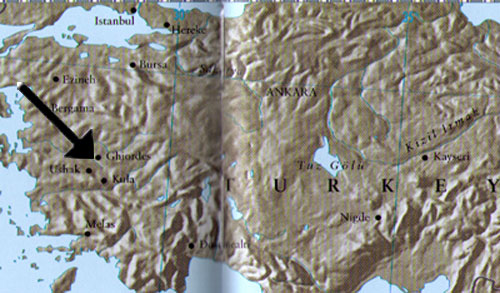 Ghiordes, as we pointed out in an earlier post, is the area in Northeastern Turkey near the ancient city of Gordium where Alexander the Great split the legendary Gordian Knot in 333 and fulfilled the prophecy that the man that unraveled the knot would become king of Europe and Asia. Ghiordes is also the name for the Turkish Knot itself–again as shown in an earlier post.
Ghiordes, as we pointed out in an earlier post, is the area in Northeastern Turkey near the ancient city of Gordium where Alexander the Great split the legendary Gordian Knot in 333 and fulfilled the prophecy that the man that unraveled the knot would become king of Europe and Asia. Ghiordes is also the name for the Turkish Knot itself–again as shown in an earlier post.
It seems that Ghiordes Prayer Rugs, the supreme accomplishment of this rug-weaving area, are very distinctive and therefore easily recognized. Quoting a piece from the website belonging to Nazmiyal Antique rugs: Ghiordes Rugs (also spelled Giordes) – The famous rugs of Ghiordes captured the hearts of European collectors in the 1700s. Early Ghiordes prayer rugs are among the most iconic of their type in Anatolia and the surrounding area. They traditionally feature angular prayer niches, highly decorative spandrels, architectural pillars and gorgeous monochromatic fields. These stunning rugs are typically made from the highest quality wool, which is placed over a hand-spun cotton foundation. This construction technique produces beautiful and extremely durable rugs. I took this from the Encyclopaedia Britannica: Characteristics of the Ghiordes carpet include a finely stepped acute arch with prominent shoulders, and two cross panels, one above and the other below the niche, or mihrab….In an attempt to better understand what these two expert articles were telling me (what the hell is a spandrel?), I marked up an image with lines leading to the features as I discovered them.
1. Finely stepped acute arch
2.The arch has prominent shoulders.
3.Two cross panels: one above and one below the Niche
4. Highly decorative spandrels
5. Architectural Pillars
6. Monochromatic Fields within the Niche
Leave a Reply